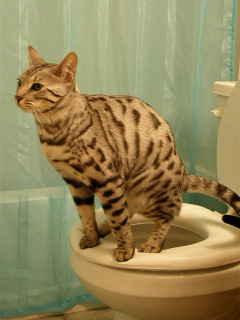Avoid Plumbing Problems: Never Flush Cat Poop Down Your Toilet - Professional Advice
Avoid Plumbing Problems: Never Flush Cat Poop Down Your Toilet - Professional Advice
Blog Article
What're your thoughts and feelings on Can You Flush Cat Poo or Litter Down the Toilet??

Introduction
As pet cat owners, it's vital to be mindful of just how we throw away our feline pals' waste. While it might seem hassle-free to flush feline poop down the toilet, this method can have detrimental repercussions for both the setting and human health.
Environmental Impact
Purging pet cat poop presents hazardous microorganisms and bloodsuckers right into the water, posing a significant danger to water environments. These pollutants can adversely affect marine life and compromise water quality.
Health Risks
Along with ecological concerns, purging cat waste can additionally posture wellness threats to human beings. Feline feces may contain Toxoplasma gondii, a bloodsucker that can trigger toxoplasmosis-- a potentially severe disease, specifically for expectant females and people with damaged body immune systems.
Alternatives to Flushing
Thankfully, there are safer and more responsible means to deal with pet cat poop. Consider the complying with choices:
1. Scoop and Dispose in Trash
The most typical approach of getting rid of pet cat poop is to scoop it right into a biodegradable bag and throw it in the trash. Make sure to utilize a specialized clutter inside story and take care of the waste promptly.
2. Use Biodegradable Litter
Opt for biodegradable cat clutter made from products such as corn or wheat. These clutters are eco-friendly and can be safely gotten rid of in the trash.
3. Hide in the Yard
If you have a backyard, think about burying pet cat waste in an assigned area far from vegetable yards and water resources. Be sure to dig deep adequate to avoid contamination of groundwater.
4. Mount a Pet Waste Disposal System
Purchase a pet garbage disposal system specifically created for cat waste. These systems use enzymes to break down the waste, reducing smell and environmental influence.
Final thought
Liable family pet ownership prolongs beyond giving food and sanctuary-- it likewise entails correct waste administration. By refraining from purging pet cat poop down the bathroom and opting for alternative disposal techniques, we can reduce our ecological footprint and secure human health.
Why Can’t I Flush Cat Poop?
It Spreads a Parasite
Cats are frequently infected with a parasite called toxoplasma gondii. The parasite causes an infection called toxoplasmosis. It is usually harmless to cats. The parasite only uses cat poop as a host for its eggs. Otherwise, the cat’s immune system usually keeps the infection at low enough levels to maintain its own health. But it does not stop the develop of eggs. These eggs are tiny and surprisingly tough. They may survive for a year before they begin to grow. But that’s the problem.
Our wastewater system is not designed to deal with toxoplasmosis eggs. Instead, most eggs will flush from your toilet into sewers and wastewater management plants. After the sewage is treated for many other harmful things in it, it is typically released into local rivers, lakes, or oceans. Here, the toxoplasmosis eggs can find new hosts, including starfish, crabs, otters, and many other wildlife. For many, this is a significant risk to their health. Toxoplasmosis can also end up infecting water sources that are important for agriculture, which means our deer, pigs, and sheep can get infected too.
Is There Risk to Humans?
There can be a risk to human life from flushing cat poop down the toilet. If you do so, the parasites from your cat’s poop can end up in shellfish, game animals, or livestock. If this meat is then served raw or undercooked, the people who eat it can get sick.
In fact, according to the CDC, 40 million people in the United States are infected with toxoplasma gondii. They get it from exposure to infected seafood, or from some kind of cat poop contamination, like drinking from a stream that is contaminated or touching anything that has come into contact with cat poop. That includes just cleaning a cat litter box.
Most people who get infected with these parasites will not develop any symptoms. However, for pregnant women or for those with compromised immune systems, the parasite can cause severe health problems.
How to Handle Cat Poop
The best way to handle cat poop is actually to clean the box more often. The eggs that the parasite sheds will not become active until one to five days after the cat poops. That means that if you clean daily, you’re much less likely to come into direct contact with infectious eggs.
That said, always dispose of cat poop in the garbage and not down the toilet. Wash your hands before and after you clean the litter box, and bring the bag of poop right outside to your garbage bins.
https://trenchlesssolutionsusa.com/why-cant-i-flush-cat-poop/

I was guided to that editorial on Can You Flush Cat Poo or Litter Down the Toilet? from a good friend on another domain. Those who appreciated our blog post please remember to share it. Thank you so much for taking the time to read it.
Click Here Report this page